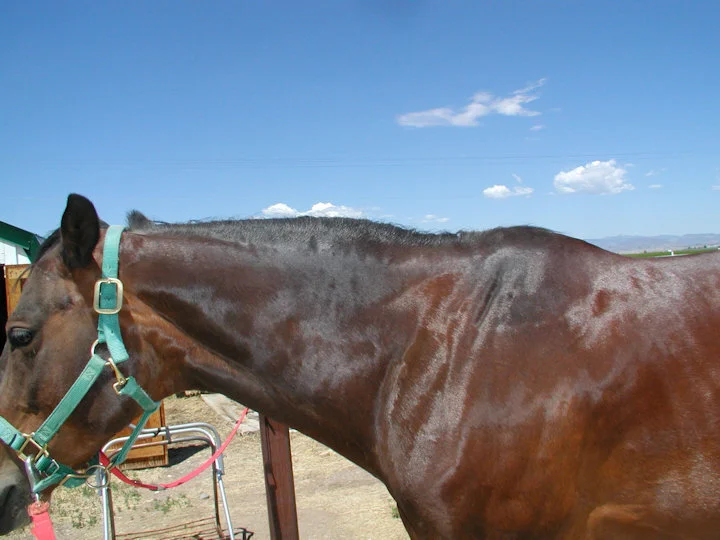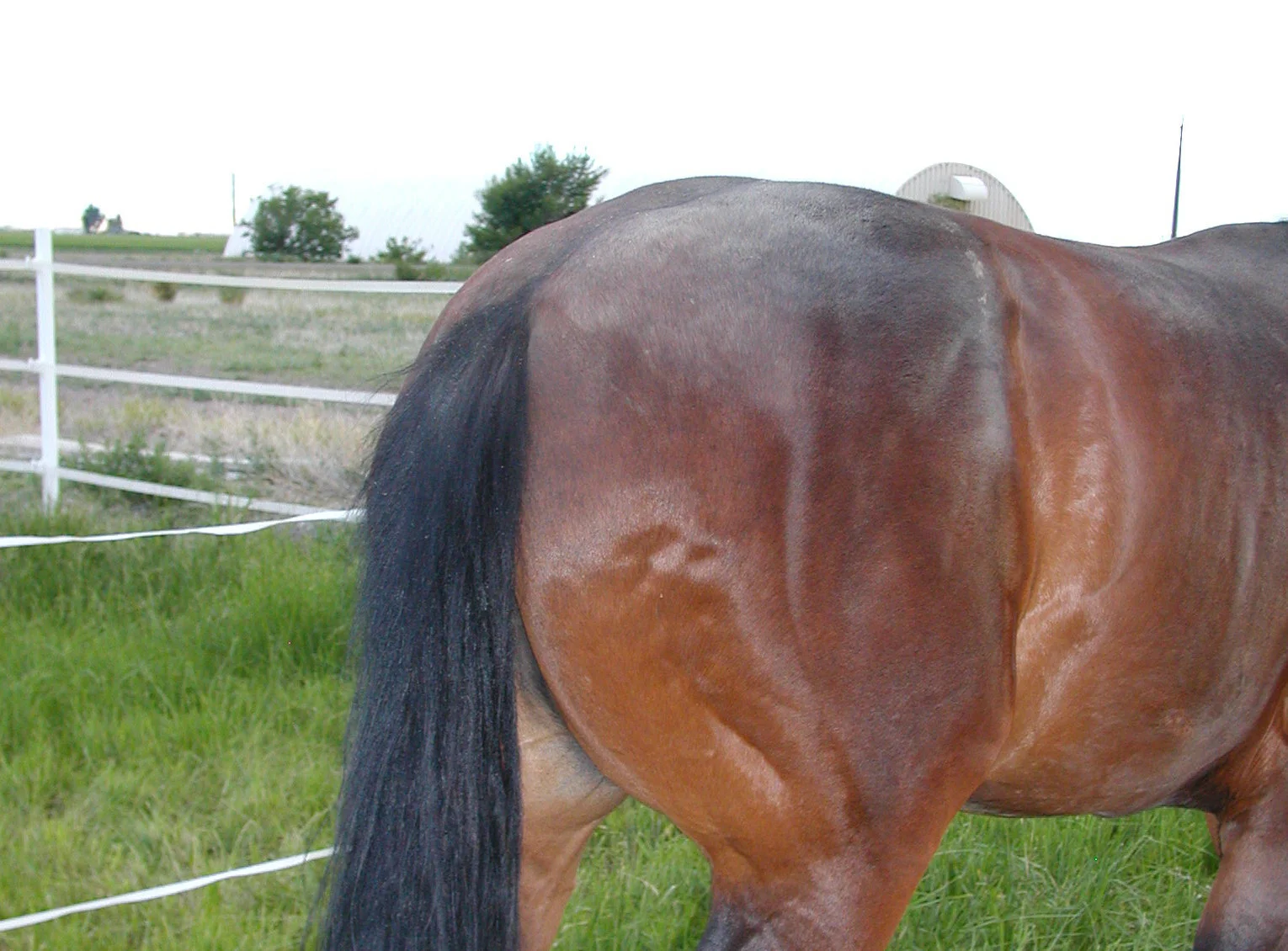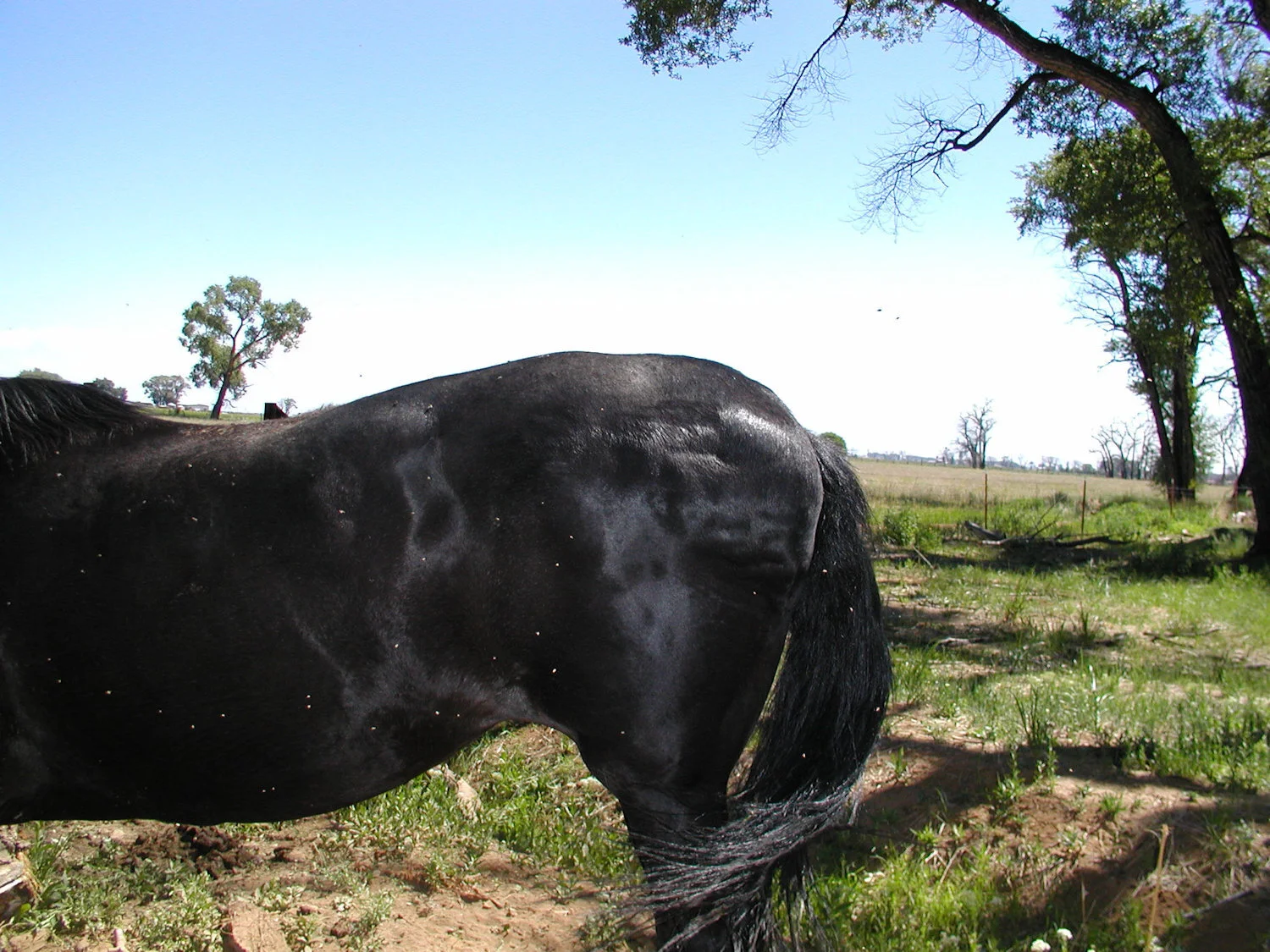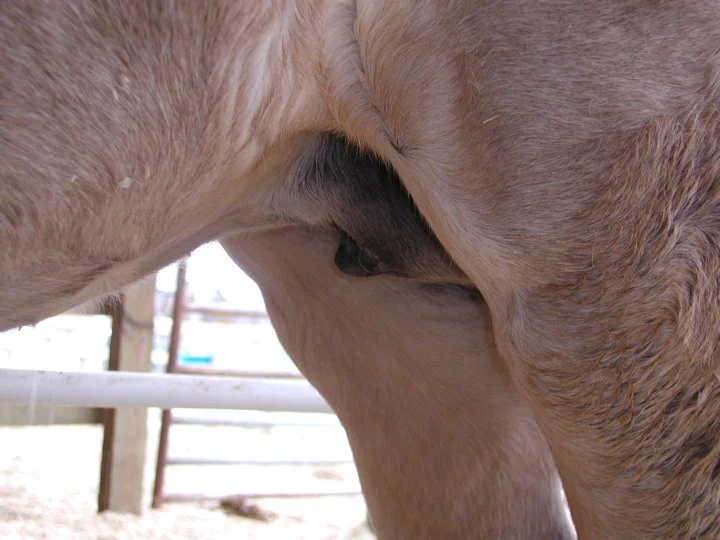What Equine Metabolic Syndrome looks like
The fat on top of the neck swells up and hardens quickly when the diet has too much sugar. It softens and gets smaller as the diet gets more appropriate.
Unlike a normal crest found on some stallions, the fat sits on top of the nuchal ligament. When palpated it moves separately from the underlying structures. These abnormal fat deposits have little correlation with overall body condition.
On horses with EMS, there is often a dip between the withers and the crest. This pony was in lean body condition.
This hyperinsulinemic pony is in moderate work and is fit, lean and well-muscled. Yet a trained eye can still see the slight crest on the neck.
Horses with EMS sometimes have a butt with dents. These fat deposits are abnormal. An obese horse with normal metabolism would have smooth fat evenly distributed over the whole body.
This is an advanced case of EMS on a horse on 24/7 pasture. This horse was foundered with badly deformed feet and had difficulty moving. The abnormal fat deposits are clearly defined.
EMS horses sometimes accumulate abnormal fat deposits above the eye. Normal horses are sunken above the eye. The areas that each EMS horse accumulates fat should be monitored to assess the suitability of the diet and exercise program.
Another spot where abnormal fat pads may develop is just behind the shoulder.
Mares with EMS may accumulate fat on the udder. Stallions and geldings may accumulate fat on the prepuce or sheath of the penis.
When weather forced a stop in exercise, my mares both developed edema in the flap of skin near the stifle. I had the vet draw a sample and he said it was serum. Within a week it had turned into solid fat.
This is my ConnemaraX. After I started traveling a lot, I met a woman who had several horses very closely related to her sire. All had chronic laminitis and hyperinsulinemia. When this picture was taken, her insulin levels were 4X normal, even though she was lean and fairly fit from 5X/week exercise at canter on field roads. When genetics drives EMS, diet and exercise may not be enough.
This horse was a bit short strided when trotting. His insulin was high on 12 hrs/day pasture. The freshly rasped feet show that subclinical laminitis has been going on for some time. When you see this, take action before the damage becomes permanent.
We now know there is a slow, simmering form of laminitis that may not cause drastic lameness. It gradually takes its toll on the structure inside to weaken the hoof wall. The heel grows faster, pushing the foot forward into this classic dished foot with underrun heels.
When the tip of the coffin bone tips down, a wedge of scar tissue forms at the toe. This should be removed to allow the hoof capsule to realign with the inner bones. Note how the hoof capsule has spaces that are unattached to the inner structures. These are often opened (resected) to dry and prevent final infection from getting established.
This pony got very lame on ryegrass/clover pasture. After putting him in a dry lot, he got much better. 3 months later, the new growth follows the new alignment of the coffin bone. The laminar wedge should be taken off to maintain the angle of the new growth/coffin bone.
When laminitis is very severe P3 can drop right through the sole. This is very serious. A horse can be rehabilitated from this, but you had better be rich, be available for intensive nursing care, and have a knowledgable team of vet and farrier. This is why we get very pro-active when our horses have mild laminitis. Prevention of damage is far easier than correcting serious damage to the inner structures of the feet.
Laminitic horse’s feet grow faster in the heel. This makes the horizontal lines or ridges curve down at the heel. The horse may not even be noticeably lame. Get pro-active and test insulin levels when you see this.
This is the proper angle to assess rotation. Place a nail or piece of wire on top. The angle between the front of P3 and the wire are the degrees of rotation. The lamellar wedge is in front of P3. A thumbtack is placed at the tip of the frog. These markers can help your farrier make corrective shoes so the foot grows out with proper support.
This is what long term neglect does to a horse with laminitis. A hacksaw will be the first tool used to start to reshape the feet. With a brave, knowledgable trimmer and correct diet, horses can be rehabbed successfully from this condition. Regular, proper trimming can eventually reshape the feet to a more normal appearance.
I would never have bred my mare if I had known she was genetically predisposed to EMS. Nor would I have bred to the cresty necked stallion regardless of his sweet personality. Now the genetic links in some lines of easy keeper breeds have been proven. Please don’t breed horses with signs of EMS.
Exercise has been proven to improve high insulin levels in horses. A proper diet with exercise is even better. Even hand walking can have a good effect on horses with EMS.
Working a horse up to a good sweat is best for horses with EMS. The only time this mare had normal insulin levels is when we galloped and cantered 4-6 miles 5X a week. Unfortunately, many people do not have the amount of time to ride that much. Consider finding another person to exercise your horse with EMS.
When part of the herd needs hard feed, and part of the herd needs a low carb diet, they will need to be separated at feeding time. Some get grained, and some get a low carb feed like beet pulp or grass pellets. This is a good time to feed a ration balancer.
We don’t know why yet, but some horses with chronic laminitis get bad when the temperature drops. This happens with no change in diet or exercise. This is my mare that was eventually put down for severe cold-related laminitis. She had miraculous recoveries every Easter and she wasn’t even a religious mare.
























